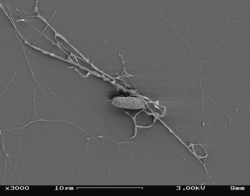| Bigyra | ||
|---|---|---|
 Aplanochytrium (Labyrinthulea) | ||
| Taxonomía | ||
| Dominio: | Eukarya | |
| Reino: | Protista | |
| (sin rango) | SAR o Harosa | |
| Superfilo: | Heterokonta | |
| Filo: |
Bigyra (P) Cavalier-Smith 1998 | |
| Subfilos y clases[2] | ||
| ||
Los bigiros (Bigyra) son un filo parafilético de organismos heterocontos. El antepasado de Bigyra y probablemente de todos los heterocontos era un organismo fagótrofo de vida libre. Bicosoecea y Placididea son los únicos grupos de esta línea que retienen el modo de alimentación ancestral mediante fagotrofia. Posteriormente, Opalinata y Blastocystea reemplazaron la capacidad fagótrofa ancestral por una osmotrofia secundaria cuando se convirtieron en comensales o parásitos de los animales. Por su parte, Labyrinthulea probablemente perdió su capacidad fagotrofa independientemente cuando se adaptó a un modo de vida saprobia de tipo fungoide.[3][4][2]
YouTube Encyclopedic
-
1/2Views:1 6691 148
-
Lámpara Fosfénica del Dr. Lefebure 2017
-
Stage Eveil 2 partie 3 du 12 déc 2016 Croyances & Attentes
Transcription
Filogenia
Bigyra es un grupo parafilético basal de los heterokontos y representa un grado evolutivo heterótrofo precursor del grupo de los pseudohongos y de las algas ocrofitas. Está constituido por los clados Sagenista, Opalozoa y Platysulcea estableciéndose las siguientes relaciones:[2][5][6]
| Bigyra |
| ||||||||||||||||||||||||||||||||||||||||||||||||||||||
Referencias
- ↑ https://www.irmng.org/aphia.php?p=taxdetails&id=11912885
- ↑ a b c Thomas Cavalier-Smith & Josephine Scoble 2012, Phylogeny of Heterokonta: Incisomonas marina, a uniciliate gliding opalozoan related to Solenicola (Nanomonadea), and evidence that Actinophryida evolved from raphidophytes. European Journal of Protistology 49(3) · December 2012 with 432 DOI: 10.1016/j.ejop.2012.09.002
- ↑ Cavalier-Smith, T., & Chao, E. E. (2006). Phylogeny and megasystematics of phagotrophic heterokonts (kingdom Chromista). Journal of molecular evolution, 62(4), 388-420.
- ↑ Riisberg I, Orr RJ, Kluge R, etal (mayo de 2009). «Seven gene phylogeny of heterokonts». Protist 160 (2): 191-204. PMID 19213601. doi:10.1016/j.protis.2008.11.004.
- ↑ Silar, P. (2016). Protistes Eucaryotes.
- ↑ Shiratori, Takashi; Nakayama, Takeshi; Ishida, Ken-ichiro (2015). «A New Deep-branching Stramenopile, Platysulcus tardus gen. nov., sp. nov.». Protist 166 (3): 337-348. ISSN 1434-4610. PMID 26070192. doi:10.1016/j.protis.2015.05.001. hdl:2241/00148461.
